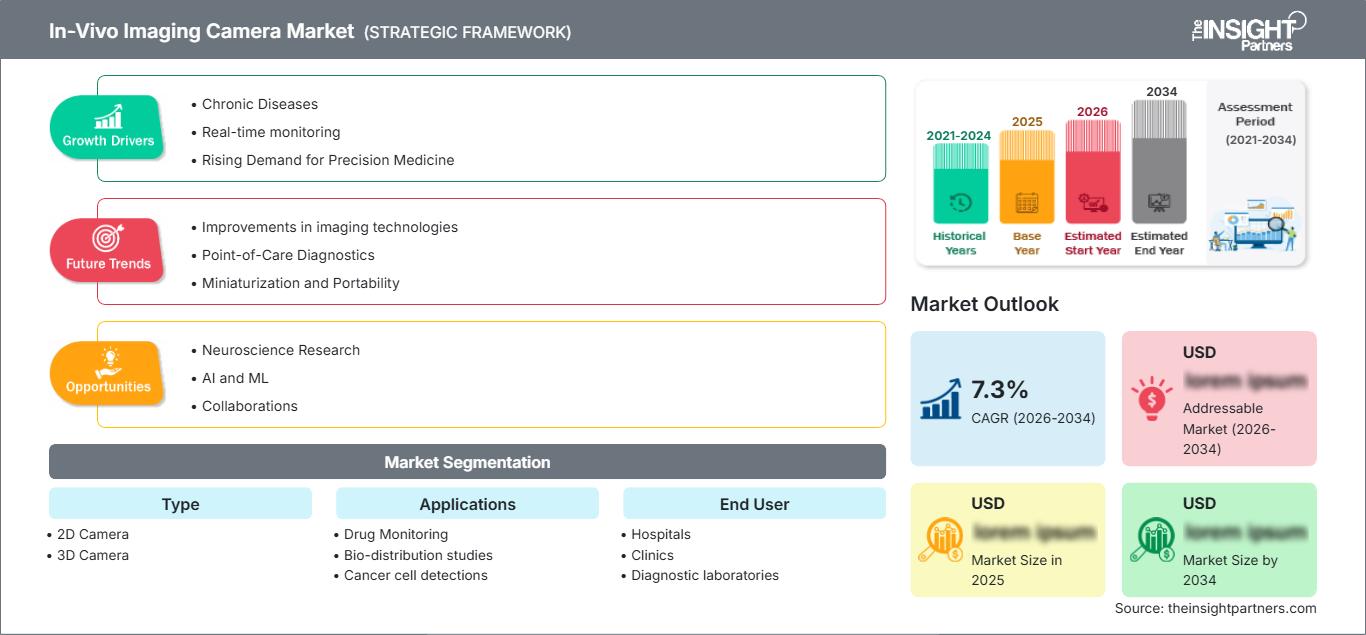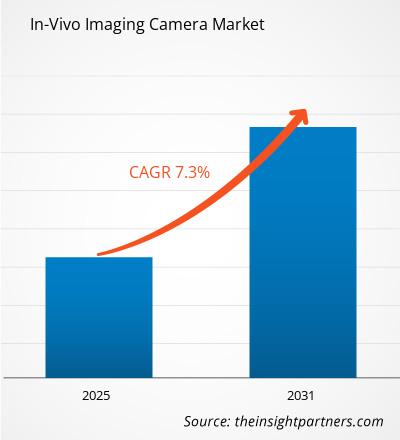The marché des appareils photo à imagerie in vivo devrait croître à un taux de croissance annuel composé de 7,3 % entre 2026 et 2034. Les conditions du marché continuent d’évoluer, ouvrant de nouvelles opportunités pour les parties prenantes. Le paysage global reflète une progression stable et un potentiel de croissance à long terme.
The rapport est divisé en quatre sections : Type (Caméra 2D, Caméra 3D), Applications (Surveillance des médicaments, études de bio-distribution, Détection de cellules cancéreuses, Autres) et Utilisateur final (Hôpitaux, Cliniques, laboratoires de diagnostic, Autres). L’analyse globale est décomposée au niveau régional et des grands pays.
Purpose du rapport Report
The In-Vivo Imaging Camera Market par The Insight Partners vise à décrire le paysage actuel et la croissance future, les principaux facteurs moteurs, les défis et les opportunités. Cela fournira des informations à divers acteurs métier, tels que :
- Technology Fournisseurs/Fabricants : Comprendre l’évolution des dynamiques du marché et connaître les opportunités de croissance potentielles, leur permettant de prendre des décisions stratégiques éclairées.
- Investors : Réaliser une analyse complète des tendances concernant le taux de croissance du marché, les projections financières du marché et les opportunités existantes sur toute la chaîne de valeur.
- Organismes de régulation : Réguler les politiques et surveiller les activités sur le marché dans le but de minimiser les abus, préserver la confiance et la confiance des investisseurs, et préserver l’intégrité et la stabilité du marché. Segmentation du marché des caméras d’imagerie
In-vivo Type
- 2D Camera
- Camera
Applications
- Drug Monitoring
- biodistribution studies
- Cancer cell detections
- Others
End User
- Hospitals
- Clinics
- Diagnostic laboratories
- Others
Geography
- North America
- Europe
- Asie-Pacific
- Sud et Centre America
- Moyen-Orient et Africa
Vous bénéficierez d’une personnalisation sur n’importe quel rapport - gratuitement - y compris des parties de ce rapport, ou une analyse au niveau du pays, un pack de données Excel, ainsi que de profiter d’offres exceptionnelles et de réductions pour les start-ups et les universités
Marché des caméras d'imagerie in vivo: Perspectives stratégiques

-
Obtenez les principales tendances clés du marché de ce rapport.Cet échantillon GRATUIT comprendra une analyse de données, allant des tendances du marché aux estimations et prévisions.
Facteurs de croissance du marché des caméras d'imagerie in vivo
- Maladies chroniques : L'augmentation de la prévalence des maladies chroniques telles que le cancer, les troubles cardiovasculaires et les maladies auto-immunes, entre autres, souligne la nécessité de disposer d'outils de diagnostic et de suivi précoces.
- Surveillance en temps réel : Les caméras d'imagerie in vivo permettent une surveillance non invasive et en temps réel des processus biologiques, ce qui permet de détecter les interventions à un stade relativement précoce. De plus, les technologies d'imagerie telles que l'imagerie par fluorescence, l'imagerie par bioluminescence et la tomographie optique continueront d'améliorer les performances des caméras d'imagerie in vivo, en offrant des images de meilleure qualité et une sensibilité accrue.
- Demande croissante de médecine de précision : L’imagerie in vivo joue un rôle crucial en médecine personnalisée en permettant la visualisation des processus biologiques aux niveaux cellulaire et moléculaire.
Tendances futures du marché des caméras d’imagerie in vivo
- Améliorations des technologies d’imagerie : La microscopie à super-résolution et l’imagerie des tissus profonds permettront aux chercheurs d’observer les processus biologiques avec une profondeur et une sensibilité sans précédent. Ceci générera de nombreuses nouvelles applications dans la découverte de médicaments, la médecine régénérative et les soins de santé personnalisés.
- Diagnostics au point de soins : La tendance croissante des diagnostics au point de soins, associée aux procédures minimalement invasives, a conduit au développement de caméras d’imagerie in vivo portables. Ces dispositifs permettraient un diagnostic plus rapide et plus précis dans les contextes aux ressources limitées et réduiraient également la charge pesant sur les systèmes de santé. Miniaturisation et portabilité : Des systèmes d’imagerie in vivo plus petits et plus portables permettront des applications au chevet du patient et une surveillance à distance. Opportunités du marché des caméras d’imagerie in vivo : Recherche en neurosciences : Les techniques d’imagerie in vivo peuvent être utilisées pour étudier les fonctions cérébrales et les troubles neurologiques. IA et apprentissage automatique : L’analyse et l’interprétation pourraient également être transformées par l’introduction de l’intelligence artificielle et de l’apprentissage automatique dans l’analyse des images provenant des caméras d’imagerie in vivo. Collaborations : Les milieux universitaires, l’industrie et les prestataires de soins de santé collaborent de plus en plus, ce qui favorise l’innovation et accélère le développement de nouvelles technologies d’imagerie in vivo. Cela offre aux entreprises la possibilité d’innover et de commercialiser des solutions d’imagerie de pointe qui répondent à des besoins cliniques réels et non satisfaits.
Marché des caméras d'imagerie in vivo
Les analystes de The Insight Partners ont analysé en détail les tendances régionales et les facteurs influençant le marché des caméras d'imagerie in vivo tout au long de la période prévisionnelle. Cette section aborde également les segments et la répartition géographique du marché de la gestion des troubles du rythme cardiaque en Amérique du Nord, en Europe, en Asie-Pacifique, au Moyen-Orient et en Afrique, ainsi qu'en Amérique du Sud et centrale.
Marché des caméras d'imagerie in vivo Report Scope
By Applications- Surveillance des médicaments
- études de biodistribution
- détection des cellules cancéreuses
- autres
- hôpitaux
- cliniques
- laboratoires de diagnostic
- autres
- Amérique du Nord
- Europe
- Asie-Pacifique
- Amérique du Sud et centrale
- Moyen-Orient et Afrique
- Royaume-Uni
- Allemagne
- France
- Russie
- Italie
- reste de l'Europe
- Chine
- Inde
- Japon
- Australie
- reste de l'Asie-Pacifique
- Brésil
- Argentine
- reste de l'Amérique du Sud et centrale
- Afrique du Sud
- Arabie saoudite
- Émirats arabes unis
- reste du Moyen-Orient et de l'Afrique
Attribut de rapport Détails Taille du marché en 2025 US$ XX Million Taille du marché par 2034 US$ XX Million TCAC mondial (2026 - 2034) 7.3% Données historiques 2021-2024 Période de prévision 2026-2034 Segments couverts By Type - Caméra 2D
- Caméra 3D
Régions et pays couverts Amérique du Nord - États-Unis
- Canada
- Mexique
Leaders du marché et profils d'entreprises clés - Olympus
- Lambert
- Zeiss
- Becker & Hickl
- Leica
- HORIBA
- PicoQuant
- Bruker
- Nikon
Densité des acteurs du marché des caméras d'imagerie in vivo : comprendre son impact sur la dynamique commerciale
The Marché des caméras d'imagerie in vivo is growing rapidly, driven by increasing end-user demand due to factors such as evolving consumer preferences, technological advancements, and greater awareness of the product's benefits. As demand rises, businesses are expanding their offerings, innovating to meet consumer needs, and capitalizing on emerging trends, which further fuels market growth.

- Obtenez le Marché des caméras d'imagerie in vivo Aperçu des principaux acteurs clés
Points clés de vente
- Couverture exhaustive : Ce rapport analyse en détail les produits, services, types et utilisateurs finaux du marché des caméras d’imagerie in vivo, offrant ainsi une vision globale.
- Analyse d’experts : Ce rapport repose sur l’expertise approfondie d’analystes et de spécialistes du secteur.
- Informations actualisées : Grâce à sa couverture des informations et tendances les plus récentes, ce rapport garantit la pertinence des données pour les entreprises.
- Options de personnalisation : Ce rapport peut être personnalisé pour répondre aux besoins spécifiques des clients et s’adapter parfaitement à leurs stratégies commerciales.
Ce rapport d’étude de marché sur les caméras d’imagerie in vivo peut donc contribuer à décrypter et comprendre le contexte sectoriel et les perspectives de croissance. Malgré quelques points à améliorer, les avantages globaux de ce rapport tendent à surpasser ses inconvénients.
- Analyse historique (2 ans), année de base, prévision (7 ans) avec TCAC
- Analyse PEST et SWOT
- Taille du marché Valeur / Volume - Mondial, Régional, Pays
- Industrie et paysage concurrentiel
- Ensemble de données Excel
Rapports récents
Rapports connexes
Témoignages
Raison d'acheter
- Prise de décision éclairée
- Compréhension de la dynamique du marché
- Analyse concurrentielle
- Connaissances clients
- Prévisions de marché
- Atténuation des risques
- Planification stratégique
- Justification des investissements
- Identification des marchés émergents
- Amélioration des stratégies marketing
- Amélioration de l'efficacité opérationnelle
- Alignement sur les tendances réglementaires






















 Obtenez un échantillon gratuit pour - Marché des caméras d'imagerie in vivo
Obtenez un échantillon gratuit pour - Marché des caméras d'imagerie in vivo